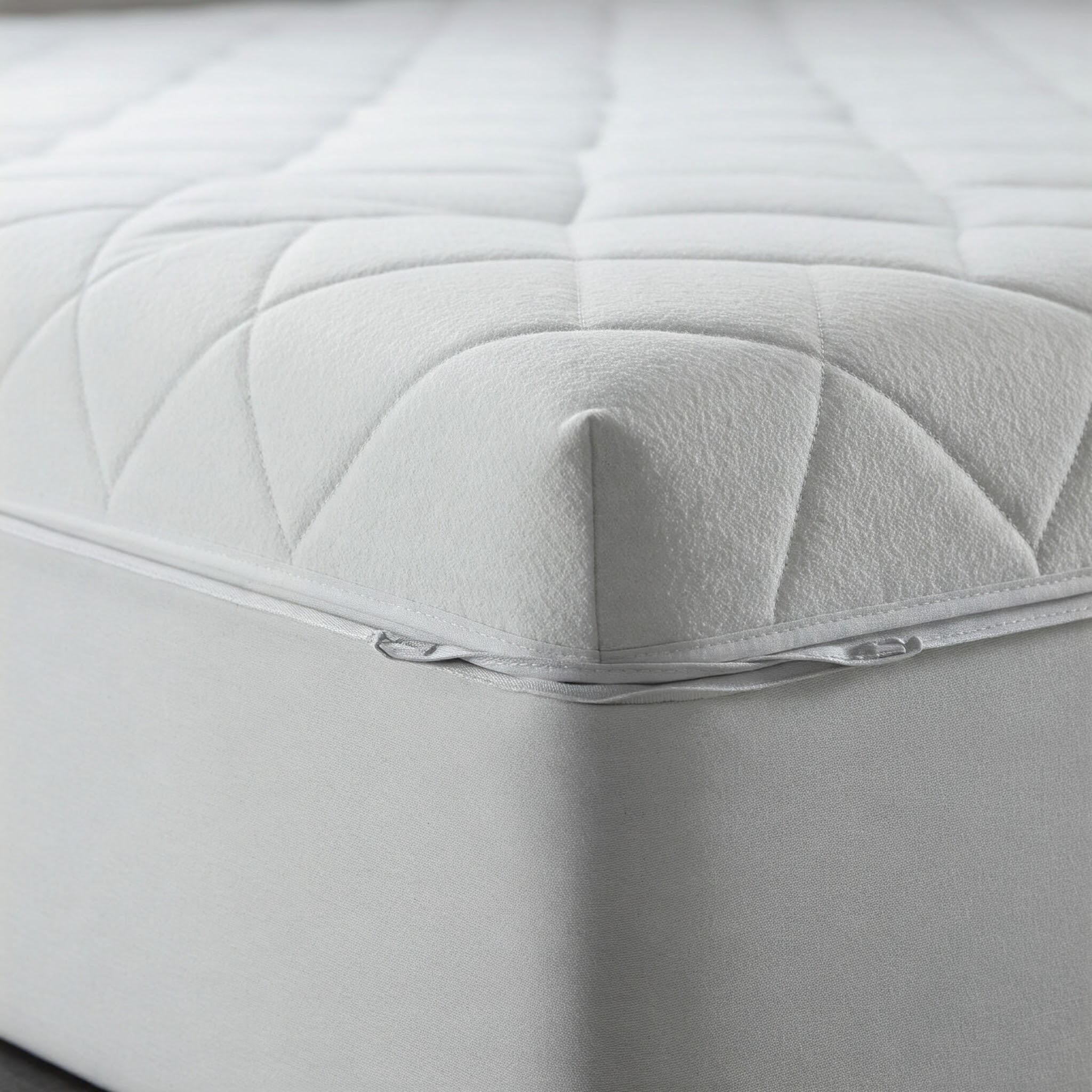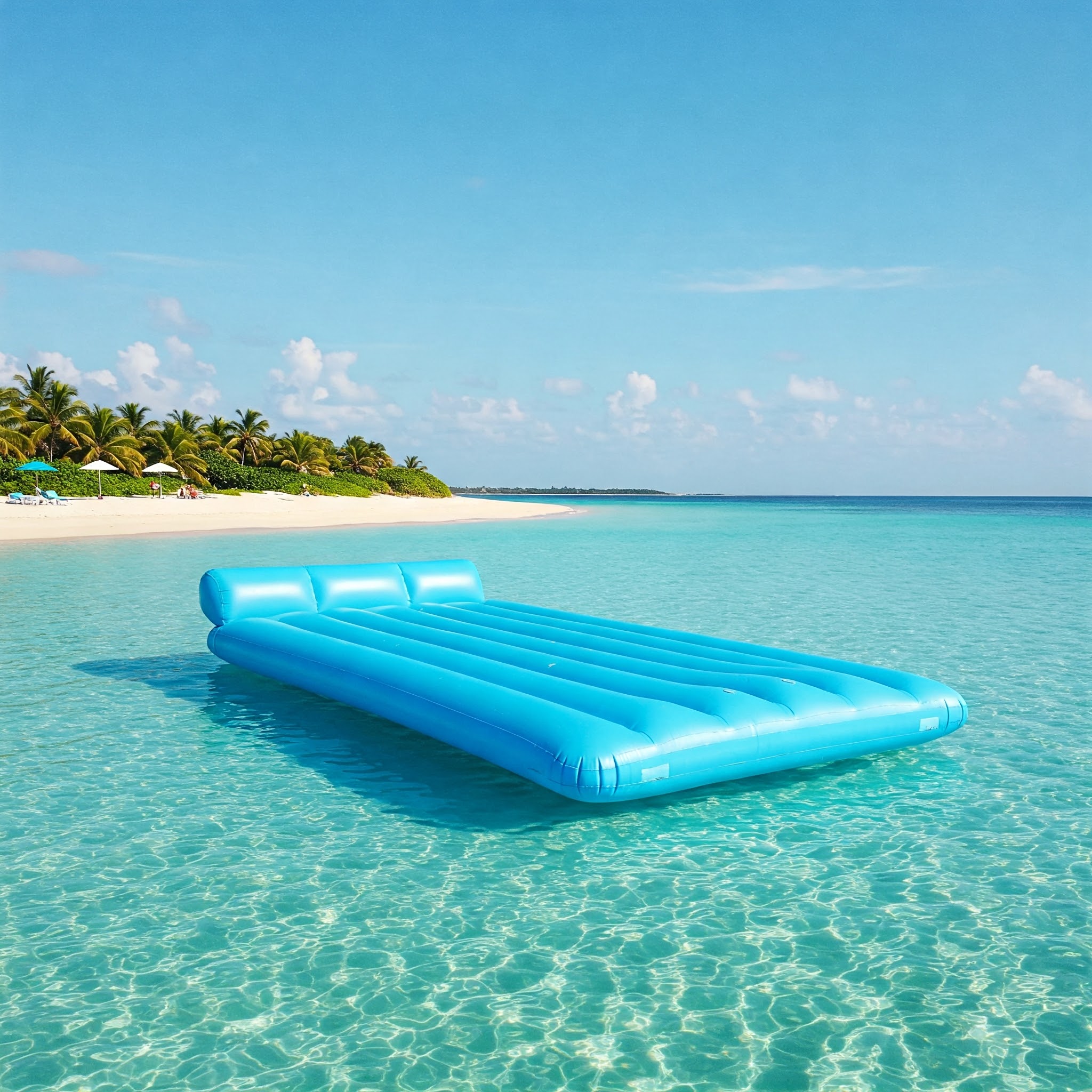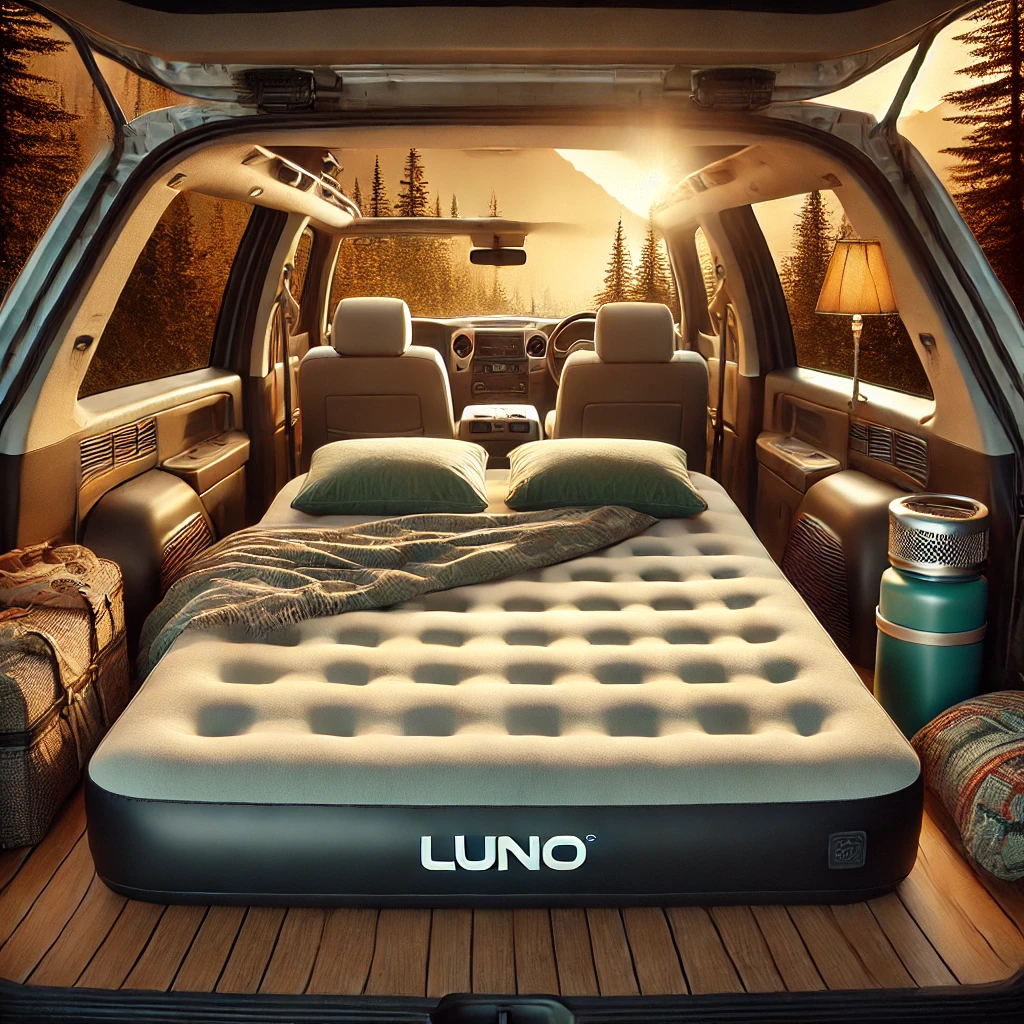Are you looking for the perfect mattress topper cover to protect your sleep investment? A quality mattress topper cover is essential for extending the life of your topper while enhancing your comfort. In this comprehensive guide, we’ll explore everything you need to know about mattress topper covers, from their benefits to the best options available on the market today.
✨Was this helpful? Spread the word! 🚀
What Is a Mattress Topper Cover and Why Do You Need One?
A mattress topper cover is a protective layer specifically designed to encase your mattress topper, creating a barrier between your body and the topper material. While many people invest in quality mattress toppers to enhance comfort, they often overlook the importance of protecting that investment with a dedicated cover.
Your mattress topper cover serves multiple important functions. First and foremost, it shields your topper from everyday wear and tear, body oils, sweat, and accidental spills. Additionally, a good mattress topper cover can enhance comfort by providing an extra layer of softness or temperature regulation, depending on the material.
According to a study published in the Journal of Sleep Research, maintaining a clean sleeping surface can significantly improve sleep quality and duration. The research indicates that allergens and irritants that accumulate on unprotected sleep surfaces can disrupt your sleep cycle and potentially contribute to respiratory issues over time.

Key Benefits of Using a Mattress Topper Cover
🛡️ Protection From Wear and Tear
One of the primary benefits of a mattress topper cover is its ability to shield your topper from daily wear. Mattress toppers, especially those made from memory foam or latex, can be significant investments. A quality cover acts as a sacrificial layer, taking the brunt of friction and pressure so your topper doesn’t have to.
🦠 Hygienic Barrier Against Allergens
Mattress topper covers create an essential barrier against dust mites, allergens, and bacteria. The Sleep Foundation notes that an unprotected sleep surface can harbor millions of dust mites, which are a leading cause of nighttime allergies and asthma symptoms. A waterproof or hypoallergenic mattress topper cover can significantly reduce these concerns.
🧼 Easy Cleaning and Maintenance
While mattress toppers themselves can be challenging to clean, most mattress topper covers are machine washable. This convenience makes maintaining a clean sleep environment much simpler. Regular washing of your mattress topper cover (experts recommend every 2-4 weeks) can remove accumulated allergens, skin cells, and oils.
🌡️ Temperature Regulation
Many premium mattress topper covers incorporate temperature-regulating technologies. Materials like bamboo, Tencel, or covers with phase-change materials can help maintain optimal sleeping temperatures throughout the night. According to research published in the International Journal of Environmental Research and Public Health, maintaining an ideal sleep temperature between 65-68°F (18-20°C) is crucial for quality rest.
⏱️ Extended Lifespan of Your Mattress Topper
Perhaps the most compelling reason to invest in a quality mattress topper cover is the extended lifespan it provides for your topper. A properly protected topper can last years longer than an unprotected one, making a cover a cost-effective addition to your bedding arsenal.
Types of Mattress Topper Covers
Waterproof Mattress Topper Covers
Waterproof covers are ideal for protecting against spills, accidents, and bodily fluids. Modern waterproof covers use polyurethane or TPU (thermoplastic polyurethane) membranes that block liquids while remaining breathable. These covers are particularly valuable for:
- Households with children
- People who enjoy breakfast in bed
- Those with pets who share sleeping space
- Individuals with incontinence concerns
Hypoallergenic Mattress Topper Covers
For allergy sufferers, a hypoallergenic mattress topper cover can make a significant difference in sleep quality. These covers are typically made with tightly woven fabrics that prevent dust mites and other allergens from penetrating the surface. Many hypoallergenic covers are also resistant to mold and mildew growth.
Cooling Mattress Topper Covers
If you tend to sleep hot, a cooling mattress topper cover might be the solution. These covers use specialized fabrics like:
- ❄️ Bamboo-derived rayon or viscose
- ❄️ Tencel lyocell fibers
- ❄️ Phase-change materials
- ❄️ Outlast® technology fabrics
Research from the National Sleep Foundation indicates that overheating is one of the most common causes of sleep disruption, making cooling covers a worthwhile investment for many sleepers.
Organic Mattress Topper Covers
For environmentally conscious consumers or those with chemical sensitivities, organic mattress topper covers offer a natural alternative. These covers typically use materials like:
- 🌱 Organic cotton
- 🌱 Natural wool
- 🌱 Eucalyptus-derived fibers
- 🌱 Natural latex components
Many organic covers carry certifications like GOTS (Global Organic Textile Standard) or OEKO-TEX to verify their purity and sustainable production methods.
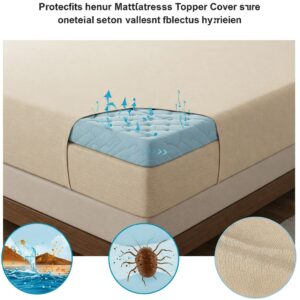
How to Choose the Right Mattress Topper Cover
Selecting the ideal mattress topper cover depends on several factors unique to your situation:
Consider Your Topper Material
Different topper materials have different cover requirements:
- Memory foam toppers benefit from breathable, moisture-wicking covers to combat heat retention
- Latex toppers pair well with organic cotton or wool covers that complement their natural properties
- Down or fiberfill toppers often need covers with baffle boxes or channels to prevent fill migration
Evaluate Your Primary Concerns
Identify your main reason for wanting a mattress topper cover:
- Allergen protection: Prioritize covers with allergen barrier properties
- Spill protection: Look for fully waterproof options
- Temperature management: Focus on cooling technologies
- Eco-friendliness: Consider organic materials and certifications
Material Quality and Construction
When evaluating mattress topper covers, pay close attention to:
- Fabric weight: Measured in GSM (grams per square meter), higher numbers indicate more durable fabrics
- Thread count: For cotton covers, a thread count between 300-500 offers a good balance of breathability and durability
- Seam construction: Reinforced or bound seams resist tearing and extend cover life
- Closure type: Zippers should be robust, preferably with protective flaps to prevent mattress contact
Top Mattress Topper Covers Comparison Table
| Product | Material | Waterproof | Hypoallergenic | Machine Washable | Best For |
|---|---|---|---|---|---|
| SafeRest Premium Mattress Topper Protector | Cotton Terry w/ Membrane | Yes | Yes | Yes | Overall Protection |
| COOP Home Goods Topper Cover | Bamboo-derived Viscose | No | Yes | Yes | Cooling & Comfort |
| Utopia Bedding Waterproof Topper Encasement | Polyester w/ TPU | Yes | Yes | Yes | Budget Protection |
| PlushDeluxe Premium Topper Cover | Organic Cotton | No | Yes | Yes | Eco-conscious Users |
| SureGuard Mattress Topper Encasement | Cotton Terry w/ Membrane | Yes | Yes | Yes | Complete Encasement |
| Bedsure Bamboo Mattress Topper Protector | Bamboo Blend | Partial | Yes | Yes | Hot Sleepers |
| Sleep Defense System Topper Encasement | Polyester | Yes | Yes | Yes | Bed Bug Protection |
| Linenspa Premium Topper Protector | Polyester w/ TPU | Yes | No | Yes | Waterproof Budget |
| AllerEase Maximum Topper Protection | Cotton Blend | No | Yes | Yes | Allergy Sufferers |
| Whisper Organics Cotton Topper Cover | 100% Organic Cotton | No | Yes | Yes | Chemical Sensitivity |
| Brooklyn Bedding Cooling Topper Protector | Phase Change Material | No | No | Yes | Temperature Regulation |
| Luna Premium Topper Encasement | Cotton Terry w/ Membrane | Yes | Yes | Yes | Full Protection |
💬 Just one click – help others make better buying decisions too!😊
🛒 Don’t Miss Our Top Picks! Check Them Out Now! 🛒
➡ Looking to protect your mattress topper investment right away? Our top recommendations combine quality, value, and effectiveness to ensure your sleep surface stays clean and comfortable for years to come. Click on any highlighted product to view current pricing and availability on Amazon!
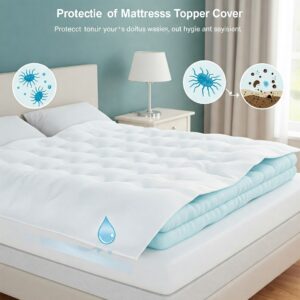
Detailed Product Reviews
1. SafeRest Premium Mattress Topper Protector
The SafeRest Premium Mattress Topper Protector stands out as our top overall recommendation for most sleepers. This cover combines a soft cotton terry surface with a waterproof membrane that effectively blocks liquids without creating the crinkly plastic feel associated with older waterproof products.
What makes the SafeRest exceptional is its balance of protection and comfort. The waterproof membrane is completely noiseless and breathable, allowing air to circulate while preventing liquids from reaching your mattress topper. The cotton terry surface wicks moisture away from your body, enhancing sleep comfort.
SafeRest’s protector is also certified to be free from vinyl, PVC, phthalates, and other potentially harmful chemicals that are sometimes found in waterproof products. Additionally, it’s earned independent certification for its hypoallergenic properties.
Users particularly appreciate the deep pockets that accommodate most mattress toppers up to 18 inches thick, ensuring a secure fit without slipping or bunching during use. The cover is also fully machine washable and can be tumble dried on low heat without compromising its waterproof properties.
2. COOP Home Goods Topper Cover
The COOP Home Goods Topper Cover is ideal for those seeking cooling properties without waterproof protection. Its bamboo-derived viscose blend creates a naturally cooling surface that helps regulate temperature throughout the night.
COOP Home Goods has built a strong reputation in the sleep product industry, and their topper cover maintains their high standards. The fabric has a luxurious feel that enhances the comfort of whatever topper it’s protecting, and the reinforced seams ensure durability even with frequent washing.
While not waterproof, this cover excels at moisture-wicking, drawing sweat away from your body during sleep. This makes it particularly suitable for hot sleepers or those living in warmer climates. The cover is also naturally resistant to dust mites and hypoallergenic.
The secure zipper enclosure ensures your topper stays fully protected, and the thoughtful design includes internal ties that keep the cover properly positioned on your topper. Many users report that the COOP cover has extended the life of their mattress toppers significantly.
3. Utopia Bedding Waterproof Topper Encasement
For budget-conscious shoppers, the Utopia Bedding Waterproof Topper Encasement offers excellent protection at a more accessible price point. Despite its affordability, this cover doesn’t compromise on essential features.
The polyester surface with TPU backing creates an effective waterproof barrier that protects against spills, bodily fluids, and accidents. The material is OEKO-TEX certified, ensuring it’s free from harmful substances.
The Utopia encasement fully surrounds your mattress topper with a zipper closure, providing 360-degree protection. This design is particularly valuable for those concerned about allergens or bed bugs, as it leaves no entry points.
While not as luxurious in feel as some premium options, the Utopia cover is practical, effective, and represents excellent value. It’s also machine washable and maintains its waterproof properties after repeated laundering when care instructions are followed.
4. PlushDeluxe Premium Topper Cover
The PlushDeluxe Premium Topper Cover is our top recommendation for eco-conscious consumers. Made from 100% organic cotton, this cover avoids synthetic materials while still providing excellent protection for your mattress topper.
The organic cotton used in this cover is GOTS certified, ensuring it meets strict environmental and social criteria throughout the production process. The fabric is naturally breathable and moisture-wicking, creating a comfortable sleep surface without petroleum-based components.
While not waterproof, the tightly woven cotton creates a natural barrier against dust mites and allergens. The fabric is substantial enough (300 GSM) to provide meaningful protection while remaining soft to the touch.
The PlushDeluxe cover features reinforced stitching and a quality zipper that fully encases your mattress topper. Users appreciate the natural feel and the peace of mind that comes with using an organic product free from potential irritants.
5. SureGuard Mattress Topper Encasement
The SureGuard Mattress Topper Encasement offers perhaps the most comprehensive protection of any cover on our list. This full encasement uses a cotton terry surface bonded to a waterproof membrane, with a secure zipper that features the company’s proprietary SureSeal technology.
What sets the SureGuard apart is its laboratory-tested effectiveness against bed bugs, dust mites, and allergens. The encasement has been independently verified to block 100% of bed bugs, making it a valuable choice for those in multi-unit housing or areas where bed bugs are a concern.
Despite its protective capabilities, the SureGuard maintains good breathability thanks to the cotton terry surface. Users report that it doesn’t sleep hot like some waterproof protectors can.
The cover is backed by a 10-year quality guarantee, reflecting SureGuard’s confidence in their product. It’s also machine washable and maintains its protective properties through multiple washings when proper care instructions are followed.
🔍 Your Ultimate Mattress Topper Cover Solution Awaits! 🛒
➡ Ready to protect your mattress topper investment? The right cover makes all the difference in extending the life of your topper while ensuring a clean, comfortable sleep environment. Click on any of our recommended products to check current pricing and availability. Your perfect night’s sleep is just a click away!
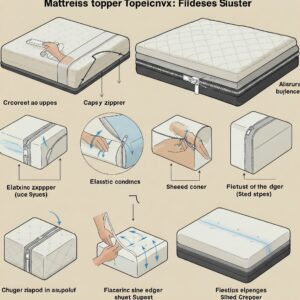
How to Properly Care for Your Mattress Topper Cover
To maximize the lifespan and effectiveness of your mattress topper cover, proper care is essential:
Regular Washing Schedule
Most manufacturers recommend washing your mattress topper cover every 2-4 weeks. However, this can vary based on:
- Your personal perspiration levels
- Whether pets share your bed
- Seasonal allergies
- Any medical concerns
For households with allergies or asthma, the American Lung Association recommends weekly washing of bedding components, including mattress topper covers.
Following Manufacturer Instructions
Each cover type has specific care requirements:
- Waterproof covers: Typically should be washed in cold or warm water and tumble dried on low heat to preserve the waterproof membrane
- Organic cotton covers: Often tolerate higher wash temperatures but may shrink if dried on high heat
- Bamboo-derived covers: Usually require gentle detergents without bleach or fabric softeners
Always check the care label on your specific product, as improper washing can compromise protective features.
Addressing Stains Promptly
If accidents or spills occur:
- Blot the area immediately with clean towels
- Spot clean with a mild solution of soap and water
- Avoid harsh chemicals that might damage waterproof membranes
- Allow to air dry completely before remaking the bed
For stubborn stains, enzymatic cleaners designed for bedding can be effective without damaging protective features.
Extending the Life of Your Mattress Topper with a Quality Cover
A quality mattress topper cover is one of the most cost-effective ways to protect your sleep investment. According to research from Consumer Reports, a properly protected mattress topper can last 3-5 years longer than an unprotected one, representing significant savings over time.
To maximize this protection:
- Use two covers if needed: For valuable toppers, some users alternate between two covers, allowing complete drying after washing before reuse
- Inspect regularly: Check for signs of wear, especially around seams and closure areas
- Address damage promptly: Small tears or broken zippers should be repaired quickly before they compromise the cover’s effectiveness
Remember that different mattress topper materials have different vulnerabilities:
- Memory foam: Particularly susceptible to liquid damage, which can break down the foam structure
- Latex: Natural latex can deteriorate with excessive moisture exposure
- Down alternative: Can clump irreparably if repeatedly soaked
A properly selected cover addresses these specific vulnerabilities, dramatically extending your topper’s useful life.
When to Replace Your Mattress Topper Cover
Even the highest quality mattress topper covers have a finite lifespan. Signs that it’s time for replacement include:
- Visible thinning of fabric
- Loss of elasticity in fitted covers
- Reduced effectiveness of waterproofing
- Persistent odors despite proper washing
- Tears or damaged closures that can’t be repaired
Most quality mattress topper covers last between 2-5 years with proper care. Considering the protection they provide to your more expensive topper, regular replacement is a worthwhile investment.
Common Problems and Solutions with Mattress Topper Covers
Problem: Cover Slips Off During Night
Solution: Look for covers with:
- Deep pockets that fully encompass your topper
- Internal ties or elastic anchors
- Non-slip bottom surfaces
- Proper sizing (measure your topper’s dimensions carefully)
Problem: Waterproof Cover Makes Noise
Solution: Modern options address this with:
- Soft fabric bonded to waterproof membranes
- TPU (thermoplastic polyurethane) instead of PVC
- Cotton terry surfaces that minimize “plastic” feel
Problem: Feeling Hot While Sleeping
Solution: Consider:
- Bamboo or Tencel covers with natural cooling properties
- Covers with phase change materials
- Avoiding vinyl-based waterproof covers which trap heat
- Cotton covers for natural breathability
Problem: Allergic Reactions Continue Despite Cover
Solution: Ensure you’re using:
- Covers with pore sizes under 10 microns (blocks dust mites)
- Complete encasement designs with secure closures
- Regular washing in hot water (130°F/54°C minimum for killing dust mites)
- Consider double-covering with an allergen-specific inner cover and comfort-focused outer cover
DIY vs. Commercial Mattress Topper Covers
While some budget-conscious consumers consider creating DIY mattress topper covers, commercial options generally offer superior protection and convenience. Commercial covers provide:
- Laboratory-tested effectiveness against liquids and allergens
- Professionally sealed seams that prevent leakage
- Specialized materials not readily available to consumers
- Proper sizing with accommodation for topper thickness
However, if you’re crafty with textile projects, simple cotton covers can be made at home. These won’t provide waterproofing but can offer basic protection against dust and wear.
Environmental Considerations for Mattress Topper Covers
As with any consumer product, sustainability concerns apply to mattress topper covers:
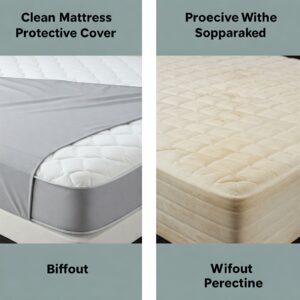
Eco-Friendly Options
Several manufacturers now offer environmentally preferable alternatives:
- Organic cotton covers with GOTS certification
- Bamboo-derived fabrics from sustainable sources
- Covers made from recycled polyester
- Biodegradable packaging
Avoiding Harmful Chemicals
Many conventional waterproof covers contain potential irritants:
- PVC (polyvinyl chloride) often contains phthalates
- Some fire retardant treatments have questionable safety profiles
- Antimicrobial treatments may include triclosan or similar chemicals
Look for certifications like OEKO-TEX Standard 100 or GREENGUARD Gold to ensure your cover is free from harmful substances.
Special Considerations for Different Sleeper Types
Hot Sleepers
If you naturally sleep warm or live in a hot climate:
- Prioritize bamboo, Tencel, or phase-change covers
- Avoid vinyl-based waterproof options
- Consider covers with moisture-wicking properties
- Look for breathable waterproof membranes if protection from liquids is needed
Allergy Sufferers
For those with respiratory allergies or sensitivities:
- Choose complete encasement designs with secure zippers
- Look for covers certified specifically for allergen protection
- Consider covers that can withstand hot water washing (130°F/54°C minimum)
- Maintain a more frequent washing schedule
Seniors or Those with Mobility Issues
If changing bedding is physically challenging:
- Look for lightweight covers that are easier to manage
- Consider options with clear top/bottom indicators
- Choose materials that resist wrinkling during changes
- Select covers with sturdy, easy-grip zippers
FAQs About Mattress Topper Covers
Are mattress topper covers the same as mattress protectors?
No, they serve different purposes. Mattress topper covers are specifically designed to protect and encase mattress toppers, which are separate comfort layers placed on top of mattresses. Mattress protectors are designed to fit and protect the actual mattress itself. The sizing, fit, and sometimes materials differ between these products.
Can I use a fitted sheet instead of a mattress topper cover?
While a fitted sheet provides some basic protection, it’s not an adequate substitute for a proper mattress topper cover. Fitted sheets typically don’t encase the bottom of the topper, leaving it vulnerable to dust and spills. They also lack specialized features like waterproofing, allergen barriers, or secure closures that prevent shifting.
How often should I wash my mattress topper cover?
Most manufacturers recommend washing every 2-4 weeks for general use. However, this should increase to weekly washing for allergy sufferers or if you experience night sweats, have pets in the bed, or during high pollen seasons. Always follow the specific care instructions for your particular cover to maintain its protective properties.
Can mattress topper covers really prevent bed bugs?
Only specially designed complete encasements can effectively prevent bed bug infestation. These covers must have secure, often zippered closures with protective flaps, and seams that are bed bug-proof. Look for covers that specifically mention laboratory testing for bed bug protection if this is a concern.
Do waterproof mattress topper covers make you sleep hot?
Modern waterproof covers are significantly improved over older versions. Many use breathable membranes like TPU (thermoplastic polyurethane) bonded to comfortable fabrics like cotton terry that allow air movement while blocking liquids. For particularly heat-sensitive sleepers, look for covers that combine waterproofing with cooling technologies like phase change materials.
Matching Your Mattress Topper Cover to Your Sleep Environment
The ideal mattress topper cover should complement both your topper and your broader sleep environment:

Climate Considerations
Your local climate affects which cover attributes matter most:
- Humid environments: Prioritize covers with moisture-wicking and mold-resistant properties
- Dry climates: Look for covers that won’t create static electricity buildup
- Variable climates: Consider seasonal cover rotation between warmer and cooler options
Bedroom Temperature Management
Your heating and cooling systems interact with your bedding:
- Air-conditioned rooms: Any cover type will generally perform well
- Heated rooms: Avoid vinyl-based covers that can trap excessive heat
- No climate control: Prioritize natural fibers that adapt to temperature changes
Considering Other Bedding Components
Your mattress topper cover should work harmoniously with:
- Sheets: Ensure your cover doesn’t create excessive friction with your sheets
- Mattress type: Some mattresses already sleep cool or warm, affecting cover selection
- Blanket weight: Heavier blankets might necessitate more moisture-wicking cover properties
Specialized Mattress Topper Covers for Unique Needs
Medical Concerns
For those managing health conditions:
- Incontinence: Look for covers with multi-layer waterproofing and odor control
- Respiratory conditions: Consider antimicrobial covers that inhibit bacteria and mold growth
- Skin sensitivities: Seek hypoallergenic materials certified free from irritating chemicals
- Mobility limitations: Choose easy-change designs with clear visual indicators
Pet Owners
If your furry friends share your bed:
- Waterproof protection becomes essential for accident management
- Durable fabrics resist damage from claws
- Easily removable designs facilitate frequent washing
- Hair-resistant surfaces minimize fur attachment
Several manufacturers now offer pet-specific covers with enhanced durability and stain resistance.
Children’s Beds
For toddlers and young children:
- Fully waterproof options protect against nighttime accidents
- Extra-durable construction withstands jumping and play
- Chemical-free materials address heightened sensitivity concerns
- Fun patterns or colors make bed-making more engaging
Making the Most of Your Mattress Topper Cover Investment
To ensure you’re getting the best return on your mattress topper cover purchase:
Proper Installation
Even the best cover provides inadequate protection if improperly installed:
- Completely remove all bedding
- Ensure your topper is clean and dry before covering
- Center the topper on your mattress before applying the cover
- Smooth out all wrinkles and folds
- Secure any anchor mechanisms (straps, elastic, etc.)
- Double-check zipper closure is complete and secured
Seasonal Rotation
Consider maintaining two different cover types:
- Cooling covers for warmer months
- Insulating covers for colder periods
- Alternating use extends the life of both covers
This approach not only optimizes comfort but represents a cost-effective way to extend cover lifespan.
Complementary Protection Strategies
For comprehensive mattress topper protection:
- Consider layering a waterproof cover under a comfort-focused cover
- Use mattress protectors beneath your topper for dual protection
- Place dust mite-proof covers on pillows to create a complete allergen barrier system
Industry Trends in Mattress Topper Covers
The mattress topper cover market continues to evolve with new technologies and consumer demands:
Sustainable Materials
Manufacturers are increasingly offering:
- Covers made from recycled ocean plastic
- Organic and sustainable fabric options
- Biodegradable packaging
- Carbon-neutral production processes
Smart Textiles
Emerging technologies include:
- Temperature-responsive fabrics that adjust to body heat
- Antimicrobial treatments derived from natural sources
- Fabrics that convert body moisture to cooling effects
- Enhanced durability through innovative weaving techniques
Consumer-Friendly Features
Newer covers often incorporate:
- Color-coded corners for easier installation
- Machine-readable care tags with QR codes linking to detailed instructions
- Transparent material information for conscious consumers
- Enhanced size ranges for specialty toppers
Conclusion: Protecting Your Sleep Investment
A quality mattress topper represents a significant investment in your sleep health, and protecting that investment with an appropriate cover simply makes good financial and hygiene sense. The right mattress topper cover extends your topper’s lifespan while enhancing your sleep experience through improved cleanliness and comfort.
Consider your personal needs—whether waterproofing, allergen protection, cooling properties, or eco-friendly materials—and select a cover that addresses your priorities. Remember that even premium covers cost significantly less than replacing a damaged topper, making them one of the most cost-effective bedding accessories available.
By properly selecting, installing, and maintaining your mattress topper cover, you’re not just protecting a product—you’re investing in years of better sleep quality and the health benefits that come with it.
💤 Ready to Protect Your Sleep Investment? Take Action Now! 💤
➡ Don’t leave your valuable mattress topper unprotected for another night! Our carefully selected recommendations provide options for every need and budget. Click on any highlighted product to check current pricing and secure your perfect mattress topper cover today!
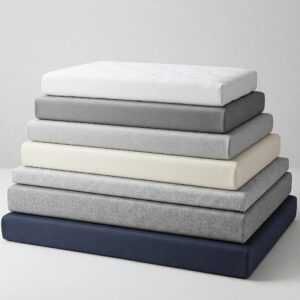
Frequently Asked Questions
❓ How often should I replace my mattress topper cover?
✅ Every 2-3 years with regular use... Quality covers typically last 24-36 months before protective properties diminish. More frequent replacement is recommended for covers used in high-moisture environments or with medical conditions...
❓ Can I put my waterproof mattress topper cover in the dryer?
✅ Yes, but only on low heat settings... High temperatures can damage waterproof membranes. Most manufacturers recommend tumble drying on low or medium-low settings to preserve the waterproof barrier and elastic integrity...
❓ What's the best mattress topper cover for hot sleepers?
✅ Bamboo-derived or Tencel covers with cooling properties... These natural materials wick moisture away from the body while allowing maximum airflow. Look for covers with grid patterns that enhance air circulation beneath your body...
❓ Are there mattress topper covers that protect against bed bugs?
✅ Yes, specialized encasement-style covers... These must feature micro-zipper technology with secure closures and reinforced seams. Effective bed bug barriers require complete encasement with no gaps larger than 0.01 inches...
❓ What's the difference between a mattress topper cover and a mattress protector?
✅ Size, fit, and specific design purpose... Mattress topper covers are designed to encase foam, latex, or fiber toppers completely, while mattress protectors fit the mattress itself. Topper covers typically have different dimensions and closure systems...
Recommended for You:
- 10 Incredible Mattress Outlet of M Deals That Will Transform Your Sleep Experience
- 10 Best Mattress for Sofa Options That Transform Your Living Space in 2025
- 10 Best Cotton Mattress Pad Options For Ultimate Sleep Comfort in 2025
Disclaimer: This article contains affiliate links. If you purchase products through these links, we may earn a small commission at no additional cost to you.
✨ Found this helpful? Share it with your friends! 💬🤗

